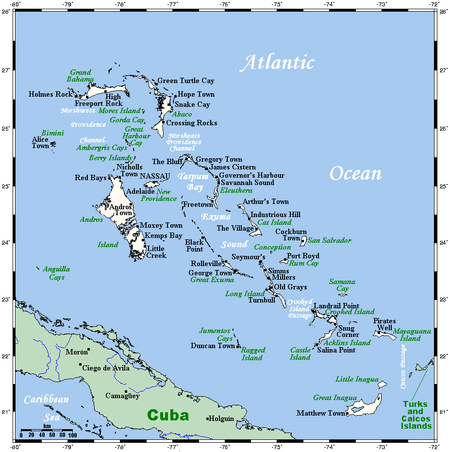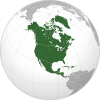Geography of the Bahamas

The Bahamas is a group of about 700 atolls and cays in the western Atlantic Ocean, of which only between 30 and 40 are inhabited. The largest of the islands is Andros Island, located 200 km (120 mi) southeast of Florida. The Bimini islands are to its northwest. To the North is the island of Grand Bahama, home to the second largest city in the country, Freeport. The island of Great Abaco is to its east. In the far south is the island of Great Inagua, the second largest island in the country. Other notable islands include Eleuthera, Cat Island, San Salvador Island, Acklins, Crooked Island, and Mayaguana. Nassau is the capital and largest city, located on New Providence. The islands have a tropical climate, moderated by the Gulf Stream.
The islands are surface projections of the three oceanic Bahama Banks - the Little Bahama Bank, the Great Bahama Bank, and the westernmost Cay Sal Bank. The highest point is only 63 meters above sea level on Cat Island; the island of New Providence, where the capital city of Nassau is located, reaches a maximum elevation of only thirty-seven meters. The land on the Bahamas has a foundation of fossil coral, but much of the rock is oolitic limestone; the stone is derived from the disintegration of coral reefs and seashells. The land is primarily either rocky or mangrove swamp. Low scrub covers much of the surface area. Pineyards are found on four of the northern islands: Grand Bahama, Great Abaco, New Providence, and Andros. On some of the southern islands, low-growing tropical hardwood flourishes. Although some soil is very fertile, it is also very thin. Only a few freshwater lakes and just one river, located on Andros Island, are found in the Bahamas.
Climate
| Precipitation | Storm | Location | Ref. | ||
|---|---|---|---|---|---|
| Rank | mm | in | |||
| 1 | 747.5 | 29.43 | Noel 2007 | Long Island | [1] |
| 2 | 580.1 | 22.84 | Dorian 2019 | Hope Town | [2] |
| 3 | 500.3 | 19.70 | Matthew 2016 | Matthew Town, Inagua | [3] |
| 4 | 436.6 | 17.19 | Flora 1963 | Duncan Town | [4] |
| 5 | 390.1 | 15.36 | Inez 1966 | Nassau Airport | [4] |
| 6 | 337.1 | 13.27 | Fox 1952 | New Providence | [4] |
| 7 | 321.1 | 12.64 | Michelle 2001 | Nassau | [5] |
| 8 | 309.4 | 12.18 | Erin 1995 | Church Grove | [6] |
| 9 | 260.0 | 9.88 | Fay 2008 | Freeport | [7] |
| 10 | 236.7 | 9.32 | Floyd 1999 | Little Harbor Abacos | [8] |
The climate of the archipelago is tropical and has two seasons, summer and winter. During the summer, which extends from May through November, the climate is dominated by warm, moist tropical air masses moving north through the Caribbean. Midsummer temperatures range from 23 to 32 °C (73.4 to 89.6 °F) with a relative humidity of 60 to 100%. In winter months, extending from December through April, the climate is affected by the movement of cold polar masses from North America. Temperatures during the winter months range from 16 to 25 °C (60.8 to 77.0 °F).
While there has never been a freeze reported in the Bahamas, the temperature can fall to 3 °C (37.4 °F) during Arctic outbreaks that affect nearby Florida. Snow has been reported to have mixed with rain in Freeport in January 1977, the same time that it snowed in the Miami area. The temperature was about 5 °C (41 °F) at the time.
Yearly rainfall averages 1,400 millimetres (55 in) and is usually concentrated in the May–June and August–October periods. Rainfall often occurs in short-lived, fairly intense showers accompanied by strong gusty winds, which are then followed by rainfalls.
Winds are predominantly easterly throughout the year but tend to become northeasterly from October to April and southeasterly from May to September. These winds seldom exceed twenty-four kilometers per hour except during hurricane season. Although the hurricane season officially lasts from June to November, most hurricanes in the Bahamas occur between July and October. Before a long lull in activity which ended in the 1990s, the last one to strike was Hurricane David in September 1979. Damage was estimated at US$1.8 million and mainly affected agricultural products. The most intense twentieth-century hurricane to strike the Bahamas was the 1929 Bahamas hurricane; winds of up to 230 kilometres per hour (140 mph) were recorded. Many lives were lost, and there was extensive damage to buildings, homes, and boats.
| Climate data for Nassau Airport, Bahamas | |||||||||||||
|---|---|---|---|---|---|---|---|---|---|---|---|---|---|
| Month | Jan | Feb | Mar | Apr | May | Jun | Jul | Aug | Sep | Oct | Nov | Dec | Year |
| Mean daily maximum °C | 25.2 | 25.3 | 26.5 | 27.7 | 29.2 | 30.7 | 31.7 | 31.8 | 31.3 | 29.7 | 27.7 | 25.9 | 28.56 |
| Mean daily minimum °C | 16.7 | 16.9 | 17.7 | 19.0 | 21.0 | 22.9 | 23.7 | 23.8 | 23.6 | 22.2 | 20.0 | 17.7 | 20.43 |
| Average precipitation mm | 47.2 | 40.3 | 39.8 | 53.8 | 116.3 | 232.9 | 157.7 | 215.9 | 171.4 | 175.5 | 56.6 | 51.8 | 1,410 |
| Mean daily maximum °F | 77.4 | 77.5 | 79.7 | 81.9 | 84.6 | 87.3 | 89.1 | 89.2 | 88.3 | 85.5 | 81.9 | 78.6 | 83.4 |
| Mean daily minimum °F | 62.1 | 62.4 | 63.9 | 66.2 | 69.8 | 73.2 | 74.7 | 74.8 | 74.5 | 72 | 68 | 63.9 | 68.8 |
| Average precipitation inches | 1.9 | 1.7 | 1.6 | 2.2 | 4.8 | 9.5 | 6.5 | 8.9 | 7 | 7.2 | 2.3 | 2.1 | 55.7 |
| Average relative humidity (%) | 78 | 78 | 76 | 74 | 77 | 79 | 77 | 79 | 81 | 80 | 78 | 78 | 77.92 |
| Source: World Climate [9] | |||||||||||||
Geography
Location

Atlantic Ocean, chain islands in the North Atlantic Ocean, southeast of Florida, northeast of Cuba and northwest of the Turks and Caicos Islands.
Geographic coordinates (capital city Nassau): 25°4′N 77°20′W
Area
- total: 13,880 km²
- county comparison to the world: 161
- land: 10,010 km²
- water: 3,870 km²
Area comparative
- Australia comparative: 6 times larger than the Australian Capital Territory
- Canada comparative: a little over twice the size of Prince Edward Island
- Poland comparative: slightly smaller than Świętokrzyskie Voivodeship
- United Kingdom comparative: slightly smaller than Northern Ireland
- United States comparative: slightly smaller than Connecticut
Land
Natural resources
Land use
- arable land: 0.8%
- permanent crops: 0.04%
- other: 98.8% (2012)
Coastline
- 3,542 kilometres (2,201 mi)
Terrain
- long, flat coral formations with some low rounded hills
Elevation extremes
- lowest point: Atlantic Ocean 0 m
- highest point: Mount Alvernia on Cat Island 63 metres (207 ft)
Irrigated land
- 10 km2 (2003)
Total renewable water resources
- 0.02 km3 (2011)
Environment
Natural hazards
- Hurricanes and other tropical storms that cause extensive flood and wind damage.
Environment - Current issues
- Coral reef decay
- Solid waste disposal
Environment - International agreements
Party to these agreements:
- Biodiversity, Climate Change, Climate Change-Kyoto Protocol, Desertification, Endangered Species, Hazardous Wastes, Law of the Sea, Ozone Layer Protection, Ship Pollution, Wetlands
Geography - note
- strategic location adjacent to US and Cuba
- extensive island chain of which 30 islands are inhabited
See also
References
- ^ Brown, Daniel P (December 17, 2007). Tropical Cyclone Report: Hurricane Noel (PDF) (Report). United States National Hurricane Center. p. 4. Retrieved April 25, 2016.
- ^ Avila, Lixion A; Stewart, Stacy R; Berg, Robbie; Hagen, Andrew B (April 20, 2020). Tropical Cyclone Report: Hurricane Dorian (PDF) (Report). United States National Hurricane Center. Retrieved April 28, 2020.
- ^ Stewart, Stacy R (April 3, 2017). Tropical Cyclone Report: Hurricane Matthew (PDF) (Report). United States National Hurricane Center. Retrieved April 6, 2017.
- ^ a b c Roth, David M. (January 3, 2023). "Tropical Cyclone Point Maxima". Tropical Cyclone Rainfall Data. United States Weather Prediction Center. Retrieved January 6, 2023.
 This article incorporates text from this source, which is in the public domain.
This article incorporates text from this source, which is in the public domain.
- ^ Beven III, John L (January 23, 2002). Tropical Cyclone Report: Hurricane Michelle (PDF) (Report). United States National Hurricane Center. Retrieved June 10, 2012.
- ^ Rappaport, Edward N (November 26, 1995). Preliminary Report: Hurricane Erin (PDF) (Report). United States National Hurricane Center. Retrieved June 10, 2012.
- ^ Beven III, John L; Stewart, Stacey R (February 8, 2009). Tropical Cyclone Report: Tropical Storm Fay 2008 (PDF) (Report). United States National Hurricane Center. Retrieved June 10, 2012.
- ^ Pasch, Richard J; Kimberlain, Todd B; Stewart, Stacey R (November 18, 1999). Preliminary Report: Hurricane Floyd (PDF) (Report). United States National Hurricane Center. Retrieved June 10, 2012.
- ^ "World Climate". Retrieved November 8, 2010.

This image is available from the United States Library of Congress Prints and Photographs Division under the digital ID {{{id}}}
This tag does not indicate the copyright status of the attached work. A normal copyright tag is still required. See Wikipedia:Copyrights for more information.
 This article incorporates public domain material from The World Factbook. CIA.
This article incorporates public domain material from The World Factbook. CIA.
Further reading
- Chenoweth, Michael (1998). "The Early 19th Century Climate of the Bahamas and a Comparison with 20th Century Averages". Climatic Change. 40 (3–4): 577–603. doi:10.1023/A:1005371320672.
{{cite journal}}: Cite has empty unknown parameters:|month=and|coauthors=(help)

